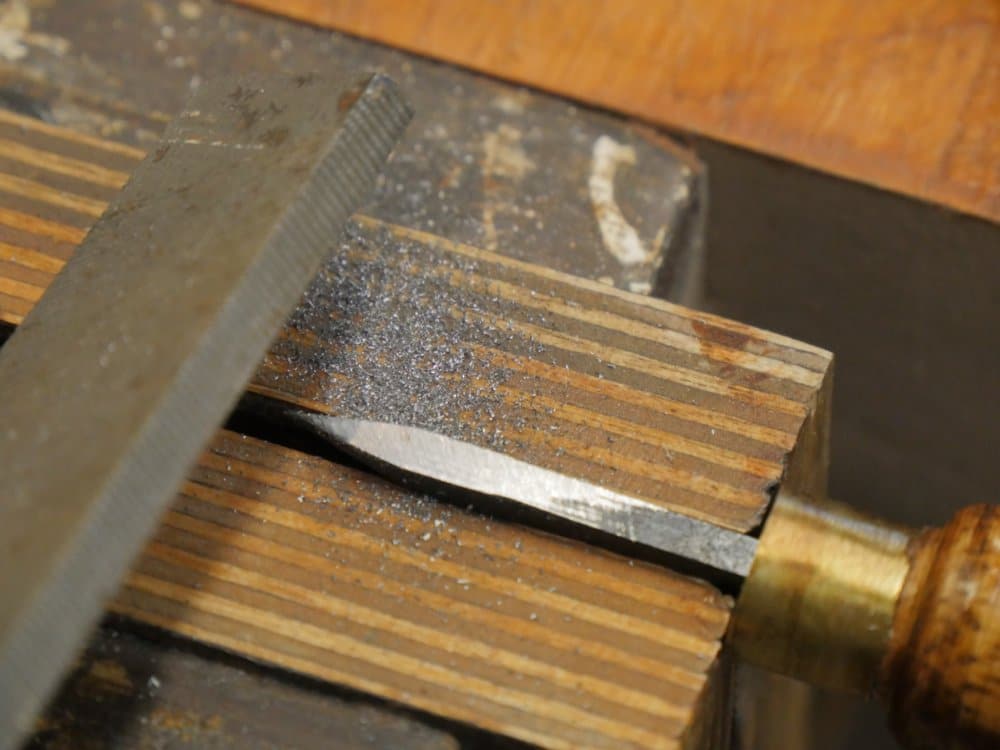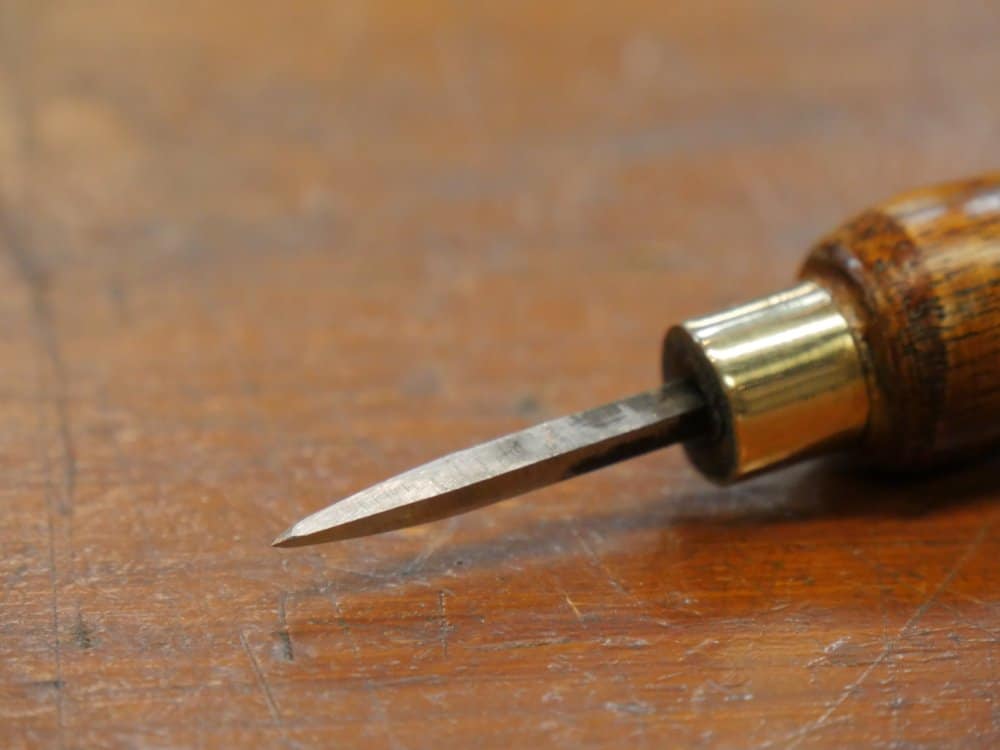Square Awls From Confused Manufacturers

That said, I took a second look at the imported Silverline square awl (above). It was really a mistake on the part of the manufacturer and of course the importer (known for cheap imports rather than a quality product) too misunderstand the key issues. They must have thought that the point of the original square awl was flawed and in need of finessing. I suppose they decided then to correct the mistake, thinking they were doing us a favour, and rounded the point like a round-pointed awl and never realised we wanted square edges not conical. To add insult to injury, they then took off the corners to the stem of the awl with a chamber to each corner when we wanted sharp, angular corners. You see we rely on the sharp corners of the point and length of the stem because the work as a reamer to actually ream out a conical hole for screws or to make a hole all the way through. All this awl will do is split wood rather than cut the hole, which is what the original was designed for as a bird-cage awl.
With the flawed perspectives dealt with I took the awl and started filing the steel blade square with a flat, single-cut file. The steel was hard enough so that was good. The wood is an Asian hardwood, stained and nicely shaped. I confess feeling glad that someone in Asian was earning a living making them but I’m not under any illusion that he or she is getting near to nothing for the work. 
OK, the brass ferrule was thick-walled and nice quality. Better than most ferrules on high-dollar awls. But somewhere in the production run someone was sloppy and left the ferrule looking ugly with finish badly applied.

I wanted to see how the awl fitted into the handle. Simple and effective really.
Refining and strengthening the tip of the awl with a pyramid point is all that remained and the awl motored through wood like a torpedo. You may want to experiment with shapes like triangles and diamonds, but square is really fine and very strong.
Before and after side by side. This is how the awl should have looked.






If someone gives you lemons you make lemonade.
If someone sells you a Wal-Mart Grade awl let Paul Sellers alone with it for a short while and he will do his darnest to turn it into a useful and beautiful awl.
Great work Paul, both on the awl and the blog writeup.
This is the problem if woodworking tools are made by people who do not work with wood.
Indeed, I totally agree.
I’ve come to believe that is true for most tools. That exact thought has been going around in my circles for many years. People that build Cadillacs drive home in Chevys.
I love to make junk work by making it better and functional. Thank you for sharing.
Is Birdcage Awls an old name for these?
Yes, birdcage awls were actually used to make carrying cages to take birds to market or transfer them to different places. The advantage of the tool is that it reams out a hole and therefore, with care, does not split the wood like a round awl inevitably does because a round awl with a conically shaped point cannot remove wood.
I know some comapnies in India that supply tools to UK and US sellers who complain that they are expected to produce the tools at a tiny fraction of the price at which they are ultimately sold. These prices do not allow them to pay high wages or invest in quality control system. Clearly sourcing tools from Asia is a two-way street and both tool makers in Asia and their patrons in the West are to blame.
This is always a deep concern to me, Indranil. I am not sure how we can turn this. If only you knew some of the jerks that run tool supply companies you would indeed understand that we will always have this problem. In most cases, there are a few exceptions I am sure, not many though, it is all very narrow intent on the bottom line being the most important and so money is the only thing that counts to them. Ethically there is a certain arrogance about the worth of men and women trying to make a living. Any thoughts you have we can discuss.
Hi Mr. Sellers,
What would you consider a good size of 01 square stock to use (length x width) if you wanted to make your own? Would you also harden it or leave it as-is? Thanks!
Personally I keep a couple of pieces of O1 for making blades and cutters. Usually you can buy bar stock in 18″ lengths and I cut out what I need. In the US you can go online to MSC. I have had success buying via eBay.
Yes I have hardened and tempered my square awls in the past. They must be fileable and not brittle as the corners do wear and need reestablishing every year or so depending on use.
I had bought an old Grace screwdriver (a brand of screwdriver common in the US, with a square wooden handle and square steel shank) to make a square awl by shortening and sharpening the blade, but found that my old Nicholson de-burring tool would do the job. They used to be common among machinists and amount to a small 3 cornered file (with the teeth ground off) fitted to a small file handle.. Easy to make with a junked 3 corner file and no need to worry about hardening. I always thought Nicholson made them from flawed files that they scraped. At any rate these are a couple of alternatives for making an inexpensive square awl.
Paul,
I glued a square masonry nail into a sandwiched handle and then re-ground the edges with a bench grinder. then I worked the surfaces on diamond stones to achieve the sharp corners. I did not include a ferrule, though I may now get a 3/4″ copper union and fit it on the tool. Thanks for the post.
Dave
I can see that working just fine, Dave.
I have used old chipping needles (used to remove slag from welds) to make smaller awls. In fact you can use them to make scribers screwdrivers lockpicks etc etc. 🙂
Thanks for this blog, I do not own a Bird Cage awl but want and need one. There are some nice ones on the market but at a hefty price, I think this might be a easy doable project.
Steve
Did C.K produce planes? I bought a plane were i live(Sweden) that was marked C.K. and havent figured out who the manufacturer were. The last owner told me that it was produced in the twenties.
Johan.
At a price, someone has listened to someone who has read this blog entry and as of the middle of June, this is what is available (assuming my eyesight hasn’t overloked shortcoming on the computer screen:
Narex and Baileys both have partial square 1/3 to 1/2″ from the tip end.
Crown has one that is square the whole length of the business end.
I have no idea about quality, except that based on chisel experience, I am also now trying out a Narex rasp.
(Crown comes at a premium, US$21.50. The other two are less)
I have no need, since I have a Yankee-style push drill and some slender, sharp fluted drill heads that might do me for a while. I also don’t like the “Birdcage” moniker: I prefer my birds either carved in wood or carved on a platter.
To make my own out of O1, what is the thickness of the square cross section? Thanks.
4mm is good.
Late to the party!
If the purpose of birdcage awls is to make starter and/or through holes for screws, would I want a few with different cross-sections?
That was the case in times past. I have abut four sizes of old ones that I have accumulated.
Pleased to say (April 2019) I just bought one of these Silverline square awls (new) from an eBay seller for the princely sum of £4.81 including delivery. It came with a square point similar to Paul’s “This is how the awl should have looked” picture.
It also looks from the blue colour on the tip like they have heat treated the tip.
Maybe they were reading.